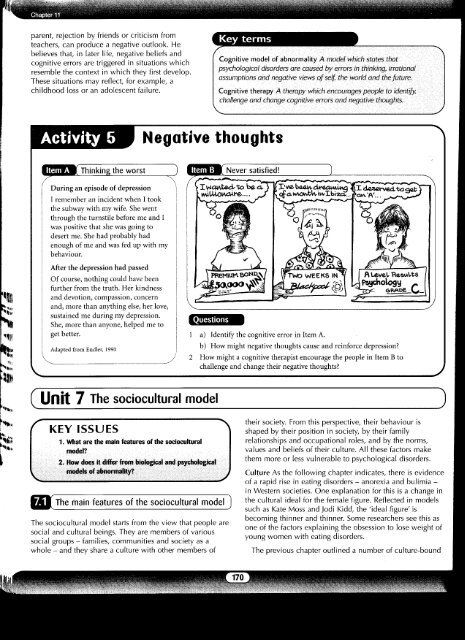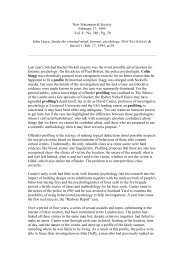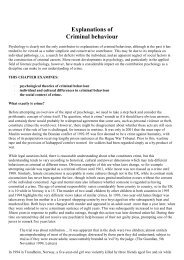Ch 11 - Jeff Standen
Ch 11 - Jeff Standen
Ch 11 - Jeff Standen
You also want an ePaper? Increase the reach of your titles
YUMPU automatically turns print PDFs into web optimized ePapers that Google loves.
parent, rejection by friends or criticism from<br />
teachers, can produce a negative outlook. He<br />
believes that, in later life, negative beliefs and<br />
cognitive errors are triggered in situations which<br />
resemble the context in which they first develop.<br />
These situations may reflect, for example, a<br />
childhood loss or an adolescent failure.<br />
r<br />
Key terms<br />
Activity 5 Negative thoughts<br />
Cognitive model of abnormality A model which states that<br />
psychological disorders are caused by errors in thinking, irrational<br />
assumptions and negative views of self, the world and the future.<br />
Cognitive therapy A therapy which encourages people to identify,<br />
challenge and change cognitive errors and negative thoughts.<br />
J<br />
l^fflBK Thinking the worst<br />
During an episode of depression<br />
I remember an incident when I took<br />
the subway with my wife. She went<br />
through the turnstile before me and I<br />
was positive that she was going to<br />
desert me. She had probably had<br />
enough of me and was fed up with my<br />
behaviour.<br />
After the depression had passed<br />
Of course, nothing could have been<br />
further from the truth. Her kindness<br />
and devotion, compassion, concern<br />
and, more than anything else, her love,<br />
sustained me during my depression.<br />
She, more than anyone, helped me to<br />
get better.<br />
Adapted from Endler, 1990<br />
A Level BasuLts<br />
Psychology<br />
r<br />
j>£fC G R A P E L»_<br />
Questions<br />
1 a) Identify the cognitive error in Item A.<br />
b) How might negative thoughts cause and reinforce depression?<br />
2 How might a cognitive therapist encourage the people in Item B to<br />
challenge and change their negative thoughts?<br />
( Unit 7 The sociocultural model<br />
J<br />
KEY<br />
ISSUES<br />
1. What are the main features of the sociocultural<br />
model?<br />
2. How does it differ from biological and psychological<br />
models of abnormality?<br />
The main features of the sociocultural model<br />
The sociocultural model starts from the view that people are<br />
social and cultural beings. They are members of various<br />
social groups - families, communities and society as a<br />
whole - and they share a culture with other members of<br />
their society. From this perspective, their behaviour is<br />
shaped by their position in society, by their family<br />
relationships and occupational roles, and by the norms,<br />
values and beliefs of their culture. All these factors make<br />
them more or less vulnerable to psychological disorders.<br />
Culture As the following chapter indicates, there is evidence<br />
of a rapid rise in eating disorders - anorexia and bulimia -<br />
in Western societies. One explanation for this is a change in<br />
the cultural ideal for the female figure. Reflected in models<br />
such as Kate Moss and Jodi Kidd, the 'ideal figure' is<br />
becoming thinner and thinner. Some researchers see this as<br />
one of the factors explaining the obsession to lose weight of<br />
young women with eating disorders.<br />
The previous chapter outlined a number of culture-bound







